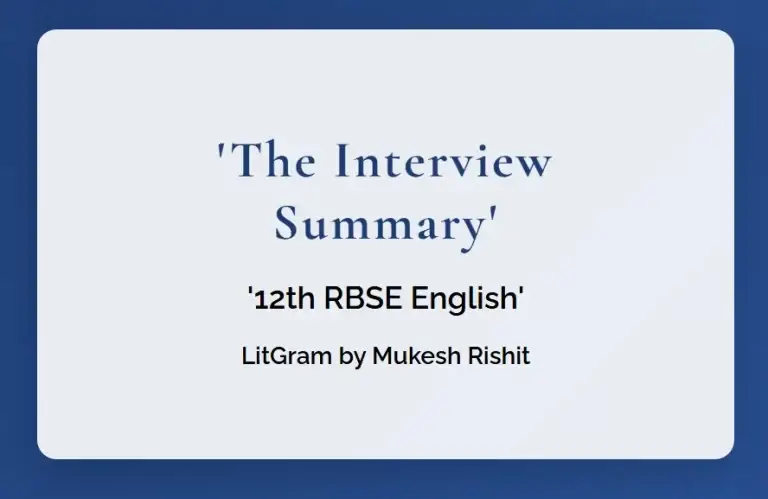Summary
In his introduction to The Penguin Book of Interviews, Christopher Silvester talks about ‘The Interview’ and offers a thoughtful exploration of interviews as both an art form and a tool of modern journalism. In Part I, Silvester outlines how the interview has become pervasive over the past 130 years while provoking strong opinions on its merits and intrusions. In Part II, we encounter an insightful conversation with Umberto Eco, who reveals the interplay between academic rigor and creative narration.
Table of Contents
Key Highlights and Quotes for 12th English RBSE
- The Evolution of the Interview:
Silvester explains that interviews were invented over 130 years ago and are now an everyday part of journalism. He observes that while most literate people have read an interview at some point, several thousand celebrities have been repeatedly interviewed. This duality ensures that interviews are seen both as a legitimate source of truth and a somewhat invasive exercise . - Diverse Opinions on Interviews:
Some interviewers champion the medium as an art that uncovers truth. For example, the text notes that in its highest form, an interview “is a source of truth” and a “vivid impression of our contemporaries” . Conversely, noted figures like Lewis Carroll and Rudyard Kipling are shown to have deeply negative associations with interviews. Carroll’s “just horror of the interviewer” and Kipling’s vehement denunciation of them—labeling them as “immoral” and “a crime” —illustrate the discomfort many feel when their privacy is invaded. - The Impact of the Interview on Personal Identity:
The excerpt introduces a fascinating belief held in some primitive cultures, where having one’s photograph taken is tantamount to having one’s soul stolen. This metaphor extends to interviews—some celebrities feel that each encounter chips away at their personality, a notion summed up by Saul Bellow’s comparison of interviews to “thumbprints on his windpipe” . - Umberto Eco’s Candid Reflections:
In the second part of the excerpt, Umberto Eco, a university professor and a novelist, shares his thoughts on writing and the narrative nature of scholarly work. He quips, “I work in empty spaces” to describe how he uses every small interval in his day to continue writing—an insight that not only underscores his creative method but also reaffirms the idea that even mundane moments can be transformed into works of art . Eco’s conversation with Mukund Padmanabhan highlights the tension between academic seriousness and literary creativity, as well as the unpredictable mass appeal of his work, notably in reference to The Name of the Rose .
Detailed Analysis
Read the Text of The Interview
Part I: The Interview as an Institution
Silvester’s excerpt opens with a clear assessment of the interview’s role in modern society. He points out the phenomenon that while the interview enables the public to gain insights into notable personalities, it also poses risks. The medium is credited with giving voice and unveiling truths but is criticized for intruding into private lives, particularly of high-profile individuals.
- Contrasting Views:
While some celebrate the interview as an “art” that distills the essence of its subjects, others—especially those who have been repeatedly spotlighted—find the practice demeaning. The text highlights this dichotomy with references to Lewis Carroll’s aversion and Kipling’s abjection as recounted in historical diaries . - The Interview’s Transformative Power:
Despite the detractors, Silvester reaffirms that “our most vivid impressions of our contemporaries are through…one man asking questions of another” . This comment underscores the role of the interviewer, who wields tremendous influence over how personalities and events are portrayed in the public eye.
Part II: A Conversation with Umberto Eco
Transitioning to the excerpt’s second section, the blog post delves into a revealing dialogue with Umberto Eco.
- Eco’s Dual Identity:
Eco positions himself as a “professor who writes novels on Sundays,” emphasizing that his academic and literary pursuits are part of a continuous narrative rather than disjointed tasks. His explanation that he uses “empty spaces”—moments between daily routines—to write illustrates his innovative approach to creative work . - Narrative in Scholarship:
A key moment comes when Eco recalls feedback on his doctoral dissertation. A professor’s remark—that Eco “told the story of [his] research, including [his] trials and errors”—resonates with his belief that academic writing can be both rigorous and engaging. This blending of narrative and scholarly pursuits not only differentiates Eco from his peers but also serves as a counterpoint to the traditionally depersonalized academic texts . - The Mystery of Mass Appeal:
Eco also reflects on the surprising success of The Name of the Rose. He shares an anecdote about how modest expectations by his American publisher clashed with the eventual multi-million book sales, highlighting the unpredictable relationship between sophisticated ideas and popular appeal . This story drives home the point that challenging intellectual work can still capture a broad audience—an inspiring insight for anyone balancing academic ambition with creative expression.
Specific Insights
- On the Artistry of Interviews:
The excerpt demonstrates that while interviews may sometimes straddle the borders of intrusion, they also serve as a dynamic method of communication that shapes public perception. The interviewer, by asking the right questions, not only documents events but also becomes a storyteller in his own right . - Eco’s Personal Philosophy:
Eco’s remarks about productivity—even in life’s empty spaces—and his balanced view of academic and nonfictional writing are especially notable. His assertion that there is value in the “narrative aspect” of research inspires readers to consider how every experience can contribute to a larger story . - Celebrity Versus Scholar:
The contrasting attitudes of celebrities and scholars toward interviews are also central. While figures like Kipling, Lewis Carroll, and even Saul Bellow have criticized the medium for its invasiveness, others relish the opportunity to share their multifaceted lives. This tension offers a rich field for further exploration in understanding how public figures navigate personal identity and media representation.
Conclusion and Key Takeaways
Silvester’s “The Interview” is more than a historical overview of a journalistic technique—it is a meditation on truth, communication, and the delicate balance between public exposure and personal integrity. The excerpt invites readers to appreciate the power of the interviewer while recognizing the very real challenges faced by those on the other side of the questioning.
- Takeaway 1: Interviews remain one of the most influential ways to capture and convey the spirit of our contemporaries.
- Takeaway 2: The conversation with Umberto Eco shows that creative productivity can thrive even in the spaces between our most routine moments.
- Takeaway 3: The diverse views on interviews—from admiration to outright rejection—highlight a lasting debate about authenticity, privacy, and the art of communication.
This reflective exploration encourages writers, readers, and scholars alike to consider both the art and the ethics of an interview, a medium that continues to shape our understanding of the world around us .
The Interview – Class 12 Questions and Answers
1. What does Christopher Silvester say about the evolution of interviews in his introduction to The Penguin Book of Interviews?
Answer:
Christopher Silvester highlights that interviews have been a significant journalistic tool for over 130 years, becoming a pervasive part of journalism. While interviews provide insights into notable personalities and their stories, Silvester also acknowledges that they provoke mixed reactions. They are celebrated as sources of truth yet criticized for intruding into private lives.
2. How does the text describe the opposing views on the nature of interviews?
Answer:
The text outlines diverse opinions on interviews. While some regard them as an art form that reveals truths and creates vivid impressions of contemporaries, others criticize them for their invasive nature. Personalities like Lewis Carroll expressed horror at interviews, and Rudyard Kipling went so far as to call them immoral and a form of theft of one’s privacy.
3. How is the comparison between photographs and interviews used in the text?
Answer:
The text draws a parallel between the belief in some primitive cultures that having one’s photograph taken steals one’s soul and the modern idea of interviews. It reflects how some individuals feel that interviews chip away at their personality or inner self. Saul Bellow describes interviews as “thumbprints on his windpipe,” emphasizing the discomfort and loss of identity caused by repeated questioning.
4. What insights does Umberto Eco share about his writing methods?
Answer:
Umberto Eco reveals that he utilizes every available moment, even the “empty spaces,” to write. He shares that he works efficiently during small intervals in his day, demonstrating how creativity can thrive amidst mundane tasks. His discipline and ability to turn everyday moments into productive ones highlight his innovative writing approach.
5. According to Umberto Eco, how does scholarly work relate to narrative techniques?
Answer:
Eco believes that academic writing can be engaging and narrative-driven. He recalls that his doctoral dissertation included storytelling elements like trials and errors, which deviated from the typically dry academic style. This blending of narrative and scholarship reflects Eco’s philosophy that even intellectual work can be artistic and compelling.
6. What does Eco say about his identity as a novelist and professor?
Answer:
Eco describes himself as “a professor who writes novels on Sundays.” He views his academic and creative pursuits as interconnected rather than separate. This dual identity reflects his ability to balance scholarly rigor with creativity, treating both domains as complementary dimensions of storytelling.
7. How does Umberto Eco explain the unexpected success of The Name of the Rose?
Answer:
Eco shares that he did not expect The Name of the Rose to achieve widespread popularity. His American publisher initially had modest expectations, printing only a small number of copies. However, the book went on to sell millions, surprising everyone. He attributes this phenomenon to the unpredictable nature of how intellectual and complex ideas can resonate with a broader audience.
8. What is the role of the interviewer as illustrated in the text?
Answer:
The interviewer plays a crucial role as a storyteller and mediator between public figures and their audiences. By asking the right questions, interviewers uncover truths and provide vivid insights into the personalities and thoughts of their subjects. However, the power they wield also raises ethical questions about privacy and intent.


